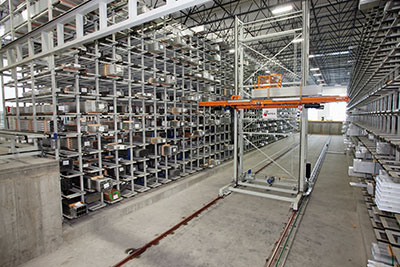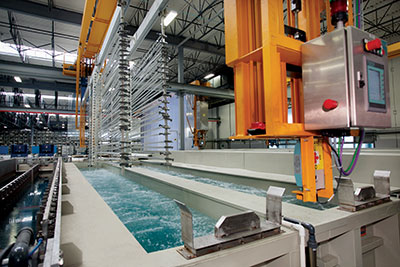
Features
Community
Under the Glass
At the Apex
A look at one of Canada’s pre-eminent aluminum extruders
June 4, 2014 By Rich Porayko
In 2009, Thomas Martini, president of western Canada-based glass
fabricator Vitrum Glass Group, realized the potential for aluminum
extruded products in the Pacific Northwest and founded Apex Aluminum
Extrusions.
In 2009, Thomas Martini, president of western Canada-based glass fabricator Vitrum Glass Group, realized the potential for aluminum extruded products in the Pacific Northwest and founded Apex Aluminum Extrusions. Martini built a brand new facility adjacent to the Vitrum headquarters in Langley, B.C., and purchased the most state-of-the-art extrusion line available. The company extruded their first billet in 2011 when other companies were running for cover.
 |
|
| The heart of Apex’s operation is a fully automated warehousing system that is unlike anything else in Canada. It enables Apex to offer its customers unparalleled flexibility in when they place and take delivery on orders.
|
“It’s difficult to understand the scope and magnitude of what Apex is all about without seeing it for yourself,” says Ron Rehwald, senior account executive for Apex. “The level of automation is second to none. We’re making some great inroads into multiple industries including glazing, window, door and aluminum railings. The growth in the last four years has been astronomical.”
If you have never been to an aluminum extrusion plant, think of a giant children’s playdough press that forces out long strands of material through a plastic die in different shapes and patterns. The basic concept is the same but it’s not that simple. Instead of playdough, the press is fed by raw aluminum bars, known as logs, that are 24 feet long and eight inches in diameter. Eighty-five percent of the logs are from Alcoa in the U.S., with the remainder sourced internationally from Australia and elsewhere. Apex uses three different alloys for their raw materials: 6061, 6063 and 6005A.
The logs are heated to 500 degrees with an energy-efficient, gas-fired furnace. The logs are then sheared to the exact required length with a fixed knife blade for a clean, flat surface. Apex operates on a full recovery system and asserts no loss of scrap raw material, meaning a cutoff from a previous log can be butted up to another log in order to eliminate any waste.
“The sheared log is the exact size that we want to extrude 300 feet of material,” says Martini. “So whether you have one hole in the die or twelve, the computer system is optimizing the exact length to the millimeter. The system has continuous feedback and automatically adjusts on the fly. If extra material is extruded, the system will log it and the next billet will be deducted by that amount.
The Apex press has huge hydraulics, weighs approximately 600,000 pounds, and has 15,000 litres of hydraulic oil for the five-foot hydraulic cylinder. At the die face at the front, there is 110,000 PSI of pressure being driven by a 1000-horsepower, servo-controlled pump. The control board for the press, which looks like a NASA control station, allows the operator to monitor the oven, the press, camera system, run-out system and production system.
“The operator doesn’t control the speed anymore. The speed is actually controlled by a thermal imaging camera system,” says Martini. “The material exits the press at around 1,100 F so the faster you go, the more friction you create, which means you have to slow down a little bit.”
“The press is constantly adjusting itself to the maximum speed set in the recipe and is trying to achieve that all the time. The temperature and speed are very critical. To meet certain specific mechanical properties, we have to break that threshold to over 1,100 degrees.”
“Fifty percent of the force/pressure is lost to friction and the other 50 per cent is what’s advancing forward into the billet. If the first half of the billet comes out at 420 C, as the press drives forward, with the friction it has created, the back of the billet might be 500 C. The system automatically accounts for this and will go very fast for the first half of the billet and slow down at the end.”
“We gain 20 per cent efficiency on our dies in running this new technology,” says Martini. “The software will allow you to go back through and review every foot of extruded material over the last 24 hours so we can monitor and control our quality every step of the way.”
Apex pre-heats the dies before they are put in the press to prevent them from acting as a heat sink. “Everything has to be the same temperature. Billet, die, holes. We’re extruding large volumes of aluminum on a 20-hour cycle. Which translates to 20-30 die changes in a day. We polish and correct the dies on a regular basis. We have approximately 1,400 active tools and copies of each one. If a customer wanted to run 20,000 kg in a run, the tool is swapped out for its spare during the run and is inspected and polished. We have our own die correction and metallurgical system for surface hardening the dies.”
“Year one we installed the extrusion line. Year two, I had this dream of anodizing and I knew we needed an automated warehouse to do it. So we added automation in year two including three automatic cranes. This crane feeds seven workstations including stacking and retrieving empty baskets, loading and unloading the oven and bringing material to the packaging department. It is running its own algorithms. No one is controlling it.
“We stack the material in the baskets automatically in sequence with a robot stacker. The material is still very malleable and you don’t want to deform it after stretching as it will remain that shape after aging. In addition it’s a waste of labour to have people stacking.”
“We cut to length, stack it in the basket, age it in the oven for 6 to 8 hours to put mechanical strength and properties back into the metal and then send to packaging. The whole process takes two days. One day for extruding and one day packaging. It’s a very quick turnaround. Our lead time is two weeks but we are filling a backlog of 500,000 kg. We monitor that daily and can make adjustments for customers that run out of material and help them out.”
“The warehouse really solves a lot of that issue,” says Martini. “We maintain a min/max inventory for customers. We can ship within 24 hours from our automatic warehouse.”
Before heading to the automated warehouse, orders are automatically bundled at the packing station. Apex receives orders from its customers which include a drawing of the exact dimensions on how the order should be packaged. “Our business is selling bundles. Five hundred kg minimums. We don’t sell stick at a time, however we sell to large distributors that do. We have probably 50 different ways that customers want their orders to be packaged.” Orders are stacked in the order specified and the station weighs the bundle and creates a barcoded packing ticket before sending the bundle to the Honeycomb.
 |
|
| Apex’s high volumes demand the capability to quickly and accurately re-tool for different job lots. The company makes 20 to 30 die changes per day, using 1,400 different tools. |
The Honeycomb is an appropriately named, mind-blowing, fully automated inventory management system. It keeps track of inventory levels and the location of the bundles. “The warehouse is the heart of our business. We changed the paradigm of extrusion because we allow customers to keep their inventory here for two to three months. They can draw from it and pull from whatever order they want to take. Loading a truck is very simple. The system scans the barcode, automatically exports those bundles and we’re done. We could never inventory 2,000 bundles like this without an automatic system because we would need a huge building and a bunch of workers on forklifts damaging and losing the material. That just doesn’t happen here. We don’t charge for this service. When we go to extrude, we don’t extrude the 500 kg minimum, we’re extruding probably 2,000 kg, so the fewer die changes saves us tremendous money and provides efficiency in downtime, lead time, scrap and other advantages.”
“With anodizing, we’re seeing that shift again,” says Rehwald. “We can anodize 30-foot lengths and we’re seeing more glazing-type customers come on board now that we began to run the largest anodizing tanks west of Toronto over the last four or five months.”
“Anodizing has been part of this industry for many years,” says Brandon Darby, plant manager for Apex Aluminum. “It’s a durable, nice finish which gives lots of versatility; however, like any finish, it does have its drawbacks. We’ve tried to engineer out the limitations that you traditionally have with anodizing through the addition of automation. If we run a bar today, tomorrow, next week or a year from now, we’re going to reach the same target with little to no variation. It gives us a much better chance of repeatability than you would normally have with a traditional anodizing line.”
“All of the product being anodized has an RFID tag on it so we have visualization in the control room and we can see where every bar is in the system at all times. We are getting real-time readings on our tank temperatures, PH levels, and wastewater information. Other plants are limited to manual and periodic sampling. Apex uses acid etch as opposed to caustic etch, providing a better gloss,” says Darby. “With a caustic etch, you are looking at a gloss variation from six to 15. It is the same colour but the gloss makes it appear to be a different colour. With acid etch, we’re able to hold between a six and nine with only a three-point variation. That provides a much better colour consistency.”
“Another advantage of acid etch over traditional caustic etch is waste of aluminum. Normally, you would etch for 13 to 14 minutes in a caustic etch. We are in the acid etch bath for 30 seconds for clear and one minute for colour. So the amount of aluminum that you are removing is far less which means the aluminum hydrate waste and waste water system is reduced dramatically. It also means the amount of aluminum that is removed to process the material is lower. From an environmental standard, these are all nice to have.These advantages allows us to sell a world-class anodizing finish to the market. We’ve really been able to minimize the traditional flaws of the anodizing process through the engineering and design of our line. It’s made a big difference.”
The anodizing advantage

|
|
Anodizing is an electrochemical process that converts the metal surface into a decorative, durable, corrosion-resistant, anodic oxide finish. Aluminum is ideally suited to anodizing, although other nonferrous metals, such as magnesium and titanium, also can be anodized. The anodic oxide structure originates from the aluminum substrate and is composed entirely of aluminum oxide. This aluminum oxide is not applied to the surface like paint or plating, but is fully integrated with the underlying aluminum substrate, so it cannot chip or peel. It has a highly ordered, porous structure that allows for secondary processes such as coloring and sealing. Anodizing is accomplished by immersing the aluminum into an acid electrolyte bath and passing an electric current through the medium. A cathode is mounted to the inside of the anodizing tank; the aluminum acts as an anode, so that oxygen ions are released from the electrolyte to combine with the aluminum atoms at the surface of the part being anodized. Anodizing is, therefore, a matter of highly controlled oxidation—the enhancement of a naturally occurring phenomenon.
– Courtesy of the Aluminum Anodizers Council, anodizing.org
Print this page
Leave a Reply